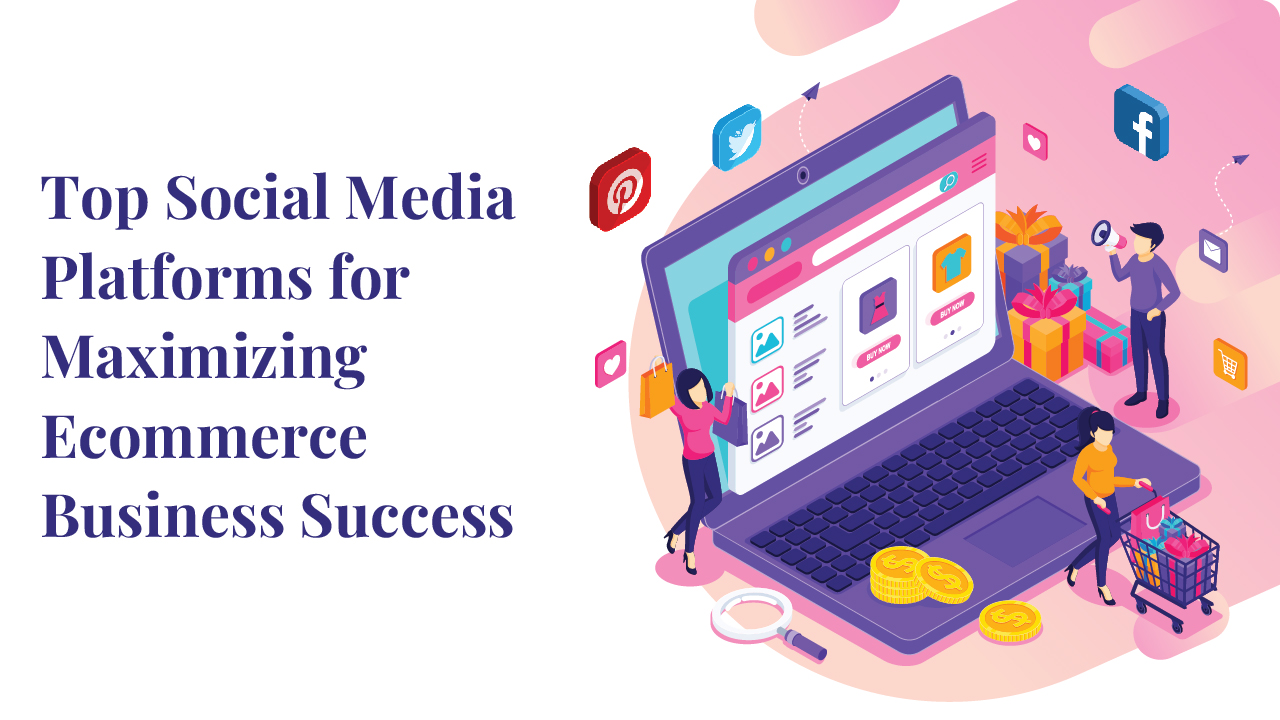
Online shopping is becoming more and more popular as time goes by. Additionally, in the new normal, people spend a lot more time on social media in addition to making more purchases from e-commerce websites. With the advent of the “Shop” capabilities, consumers are utilizing social media to browse products on company pages, read customer reviews, and even make purchases.
In order to succeed, you must continually outperform the competition and guarantee client pleasure by going the extra mile. Due to this, maintaining a social media presence is crucial for your company.
If you are considering creating social media accounts for your ecommerce business, here we have listed a few websites which you can consider using, along with tips to create your accounts and ideas for content:
Leveraging Facebook for Ecommerce Success
Facebook stands as the unrivaled giant in the social media realm, enjoying the distinction of being the most widely used social platform, the second most downloaded app, and the third most frequented website on a global scale, with a staggering 2.74 billion users who dedicate an average of 34 minutes per session.
To harness the potential of Facebook for your ecommerce venture, there are key principles to abide by. The first is the 80-20 rule, where a substantial 80% of your posts should be dedicated to educating, entertaining, and informing your followers, while the remaining 20% can be devoted to showcasing your company and its products or services. Complementing this is the rule of thirds, which advocates dividing your content strategy into three equal parts: one-third for sharing valuable ideas, one-third for fostering interactive discussions, and one-third for promoting your business directly.
When devising your content strategy, it’s imperative to incorporate videos as they consistently garner the highest levels of engagement on this platform.
Moreover, Facebook offers an opportunity to establish a dedicated Facebook Shop for your business. This involves creating a business page, populating it with a comprehensive product catalog replete with detailed descriptions and compelling images, and seamlessly integrating product tags into your posts. However, it’s crucial to note that Facebook only approves and makes your products visible to users once they align with the platform’s Merchant Terms and Policies, ensuring a seamless shopping experience for your potential customers.
Unlocking Twitter’s Ecommerce Potential
Twitter, renowned for its concise and dynamic communication style, introduces us to the world of “tweets” with a character limit of 280. The key to Twitter success lies in crafting succinct yet compelling messages, leaving room for shareability or “retweets.”
To maximize your impact, integrate visuals like videos and images into your Twitter strategy, as they consistently garner higher retweet rates. Given that a staggering 80% of Twitter users prefer its mobile app, optimizing your tweets for mobile is paramount. Ensure your messages remain concise and easily digestible, sparing users from excessive scrolling. Incorporate hashtags within your tweets rather than tacking them onto the end, increasing discoverability.
Elevate engagement through innovative tactics such as polls and Twitter chats to solicit invaluable customer feedback. Furthermore, leverage live tweeting during events, such as product launches, to infuse real-time excitement into your Twitter presence. Twitter’s brevity can be a powerful ally in your ecommerce journey when wielded thoughtfully.

Harnessing Instagram’s Visual Power for Ecommerce Success
Instagram, a visual paradise with over one billion dedicated users spending an impressive average of 29 minutes per visit, offers an undeniable platform for businesses to thrive.
Regardless of your industry, Instagram offers a welcoming stage for your brand’s narrative. Share captivating behind-the-scenes glimpses of your business, whether it’s a day in the life of your team or the intricate process behind your products. These authentic snapshots humanize your brand, forging a relatable connection that breeds customer trust and loyalty.
Much like its counterpart, Facebook, Instagram boasts a “Shop” feature, providing an avenue to transform casual scrolling into seamless shopping. The setup process mirrors that of Facebook’s, starting with eligibility confirmation. Ensure your shop aligns with supported markets, adheres to Instagram’s Merchant Agreement and Commerce Policies, and operates from a qualified website domain. Converting your account into a business profile, connecting it to a Facebook page, and establishing a product catalogue are the subsequent steps. Finally, submit your account for approval, and upon receiving the green light, unleash the shopping capabilities by navigating to Settings, selecting your product catalogue, and seamlessly tagging your products within your captivating visual content.
Instagram’s visual allure combined with its ecommerce potential presents a powerful opportunity for businesses to captivate audiences and drive sales in a visually driven world.
Unleashing Ecommerce Potential on Pinterest
Pinterest, akin to Instagram, thrives on the power of visuals, captivating a staggering audience of 459 million monthly users worldwide. With an average time spent of 14.2 minutes per session and over 14 million articles collectively pinned daily, Pinterest stands as a dynamic platform ripe for ecommerce ventures. Posts on Pinterest are called “Pins”
The impact is clear: 82% of weekly active users and 47% of millennials convert inspiration into purchases through Pins. Pins, as they’re known, serve as a wellspring of creativity, offering followers ideas spanning from home decor to recipes and fashion, readily shareable and savable. Users don’t merely browse; they embark on a journey of experimentation, documenting their experiences with photos, videos, and attached notes, forming a rich tapestry of ideas showcased in the “Tries” section of their profiles.
For businesses, Pinterest’s “Shop” tab is a game-changer, featuring buyable Pins that seamlessly guide users from a Pin’s photo directly to the brand’s website, streamlining the purchase process. Further enhancing the ecommerce experience, Pinterest’s Rich Pins dynamically update product details, including price, descriptions, and purchase links in real-time, ensuring that users stay informed and engaged.
Pinterest is not just a visual playground; it’s a thriving marketplace where inspiration transforms into action, making it a prime platform for ecommerce success in today’s image-driven world.
Conclusion: Maximizing Ecommerce Success through Social Media
In the evolving landscape of ecommerce, social media platforms have emerged as indispensable tools for businesses to thrive and succeed. Here are the key takeaways from our exploration of the top social media platforms:
- Online Shopping Boom: Online shopping is witnessing exponential growth, and social media plays a pivotal role in this trend, with users increasingly relying on these platforms to discover, evaluate, and purchase products.
- Customer Engagement: Social media platforms provide direct channels for engaging with customers, fostering trust, and building brand loyalty through interactive content and engagement strategies.
- Diverse Audiences: The vast and diverse user bases on platforms like Facebook, Twitter, Instagram, and Pinterest offer businesses the opportunity to reach a wide range of potential customers, spanning different demographics and interests.
- Content Strategies: Crafting effective content strategies, including visuals, videos, and engaging storytelling, is essential for capturing and retaining the attention of social media users.
- Shopping Features: Many social media platforms now offer shopping features such as Facebook Shops and buyable Pins on Pinterest, streamlining the path from discovery to purchase for customers.
- Real-time Updates: Features like Pinterest’s Rich Pins ensure that product information remains up-to-date, enhancing the shopping experience and reducing friction for users.
- Humanizing Brands: Sharing authentic, behind-the-scenes content humanizes brands, fostering relatability and trust among customers.
- Concise Communication: Twitter’s concise format encourages impactful messaging, making it a powerful platform for driving engagement and shareability.
- Innovation and Interaction: Creative tactics like polls, chats, and live events on social media platforms provide businesses with opportunities to gather feedback, gather insights, and create excitement around their products or services.
- Seamless Shopping: The integration of shopping features and easy navigation within social media platforms simplifies the shopping experience, leading to increased conversions and customer satisfaction.
In conclusion, the synergy between ecommerce and social media is undeniable. To succeed in the competitive world of online commerce, maintaining a strong social media presence and effectively leveraging these platforms is not just an option; it’s a necessity. By following best practices and embracing innovation, ecommerce businesses can maximize their success and stay ahead in the dynamic world of digital commerce.
You may also like
Revalsys’s Fulfilment Dashboard For E-Commerce Businesses
